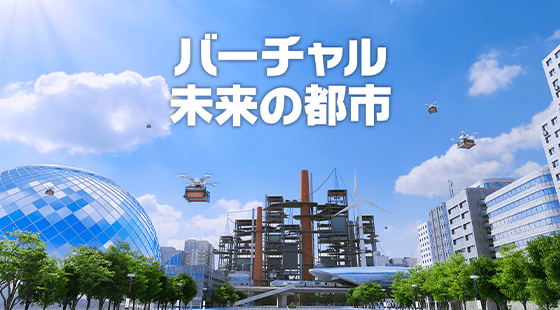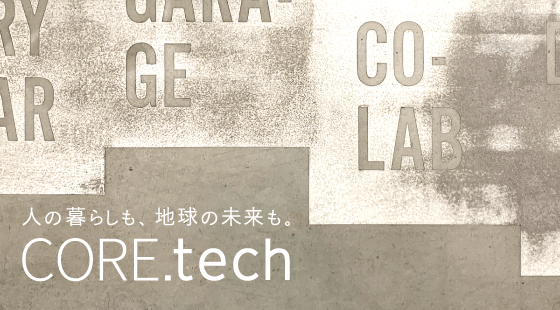

Explore the themes of our
Future City exhibit
at Expo 2025 Osaka, Kansai, Japan!
Whether you’ve seen the exhibit
and would like a recap,
or want to get an idea of what it’s
about before you go,
why not explore the future of resources
and energy with us!
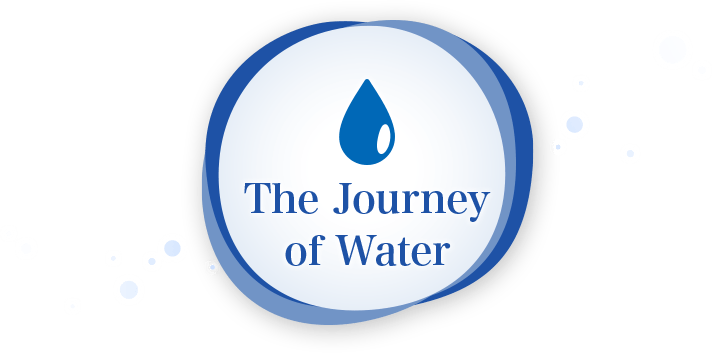
A futuristic water
management system
that maximizes the gift of
water and protects us against threats,
making life safe, secure and prosperous
-

By providing water resources where
and when they are needed,
this system will help to solve water
shortages and flooding issues,
enriching the lives of people who live
in river basin areas.News reports tell us of an alarming rise in natural disasters all over the world. In Japan, flooding and heavy rain caused by typhoons and linear precipitation zone, and resulting damage to infrastructure, have increased rapidly since the year 2000. Meanwhile, the amount of usable freshwater in groundwater, rivers and lakes makes up just 0.8% of the Earth’s total water. Now more than ever, it is vital to find ways to use water resources effectively.
The water on planet Earth is constantly circulating. Water from oceans and rivers evaporates by the heat of the sun, forms clouds in the sky, then falls to the ground as rain or snow, and collects as rivers that flow to the ocean. The water that we use is one part of this circulating water. This means that to build a sustainable society, it is important to properly manage water resources and maintain a healthy water cycle.
As well as contributing to sustainable economic activities by supplying water resources from forests and rivers to where and when they are needed, the water management system will help to prevent and mitigate disasters like flooding. It will also lead to recovery and conservation of the ecosystems of rivers and waterways.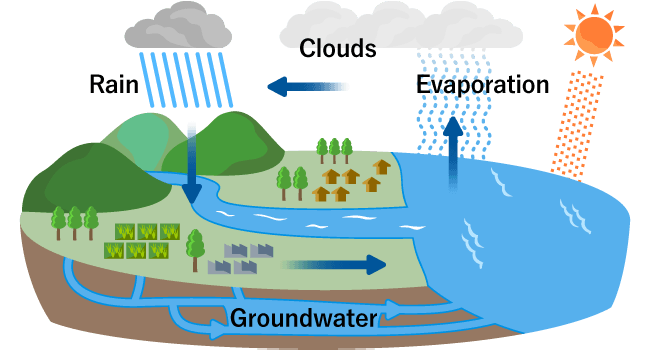
-

Water management systems already
exist, but we want to create
a more advanced system to
comprehensively manage the water cycle.Currently, water management systems are used to centrally manage water in agricultural waterways, rice fields, and balancing ponds. Based on information about water levels and flow rates, the system can suggest the optimum way of operating sluice gates to reduce supply when there is sufficient water and increase supply when there is a shortage, contributing to a stable supply of water resources for agricultural use.
There are also dam and river management systems, which use information about rainfall, water levels and flow rates to predict reservoir volumes and water level fluctuations. Operating sluice gates based on these results supports the efficient use of water resources, such as flood control during heavy rains and water conservation.
But these existing systems usually involve operators on site making the final decisions and actually operating sluice gates. As flooding and water shortages are predicted to become more frequent and more severe in future, we need a system that can quickly mitigate flooding risks with as little human involvement as possible. As well as refining existing systems, we must integrate them with solutions such as weather observation technology and remote and automatic operation of sluice gates, creating a more advanced system to comprehensively manage the water cycle.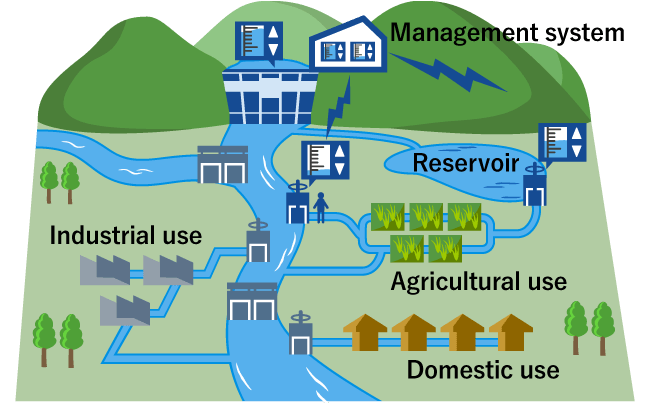
-

There are challenges at both the phase
of understanding water,
and the phase of storing and
distributing water.Understanding water
In order to manage water resources for the whole river basin, it is vital to properly understand water resources.
- Amount of water resources : How much water is currently stored in dams and reservoirs? Is this amount increasing or decreasing?
- Amount of water required : How much water is required, where and when, for agriculture, industry and domestic use?
We need to combine these predictions with accurate weather prediction to fully understand water resources.
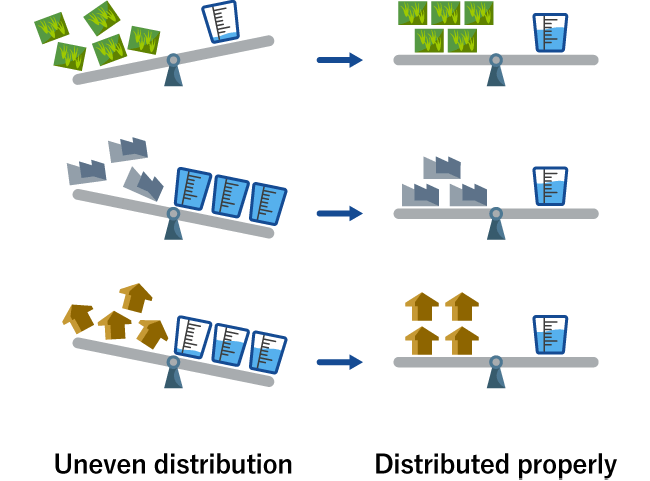
Storing and distributing water
Water needs to be stored using dams, reservoirs and ponds, and properly distributed so that exactly the right amount of water is provided to where it is needed.
- Real-time information sharing and utilization : Sharing information about the state of rivers and dams so that sluice gates can be operated based on more accurate information
- Remote operation and automatic operation : Systems allowing infrastructure to be operated quickly and safely
As well as a lack of operators due to labor shortages and the ageing population, more severe and more frequent flooding due to climate change is making the job harder.
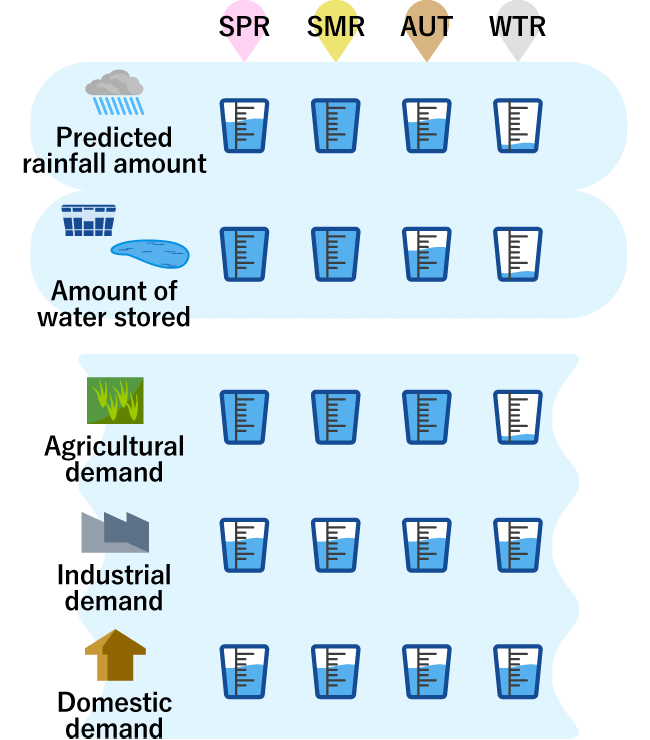
-

We are developing technologies and
solutions and bringing them together
to create a water management system
that will not only help to prevent and
mitigate disasters,
but will also enrich people’s lives.Understanding water
●Technology to obtain high-resolution rainfall data
We are harnessing high-density weather observation technology (POTEKA), as well as AI analysis and satellite observation technology currently being developed, to ascertain the movement of water that cannot be seen: groundwater and water vapor. Using real-time observation to spot signs of weather changes like linear precipitation bands, more detailed rainfall data and more accurate rainfall predictions will enable us to propose the optimal way to operate infrastructure.
Storing and distributing water
●Operation support system to remotely/automatically operate sluice gates in the event of heavy rain
We are developing support systems to remotely and automatically operate sluice gates in the event of heavy rain, which is usually done by operators on site; technology to automate decision-making by operators based on the conditions on site; and diagnostic technology to identify deterioration of aging sluice gate facilities.
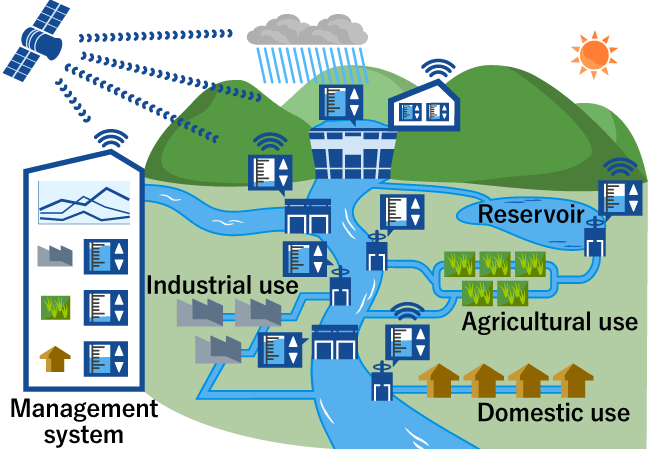
-

-
IHI Engineering Review
Transition from Experience-Based Water Distribution Management to a Data-Driven
Approach
Water Distribution Master —A tool that supports water distribution for optimized
agricultural water management— -
IHI Engineering Review
Preserving and Managing Tropical
Peatlands Using Simulation Technology
Simulation technology to visualize groundwater levels in tropical peatlands -
CORE.tech
How to Foster a “Small” Project into Collaborative Community Activities
-

Clean energy system using
fuel ammonia
to transform power
generation
as a step toward a
zero-carbon future
-

Replacing the fossil fuels used to
generate power with fuel ammonia
will significantly reduce CO2 emissions,
helping to achieve a carbon neutral
society.Over 120 countries and regions have pledged to become carbon neutral by 2050. Globally, there are calls to reduce greenhouse gas emissions in every sector.
Thermal power generation is vital to ensuring a stable supply of electricity, but the fossil fuels currently used, like coal and natural gas, emit CO2 when burned. The power generation sector accounts for around 40% of Japan’s total CO2 emissions, most of which comes from thermal power generation*1. To achieve net zero, it is necessary to reduce CO2 emissions from thermal power plants.
IHI believes that ammonia is the answer. Ammonia is a carbon-free fuel, which means it does not emit CO2 when burned. Ammonia is already widely used around the world as a raw material in fertilizers and other chemicals, so the technologies for its production, transportation and storage are well established. Being able to use ammonia as fuel for thermal power generation would slash CO2 emissions. That’s why ammonia is expected to come into use in the near future as a next-generation energy source.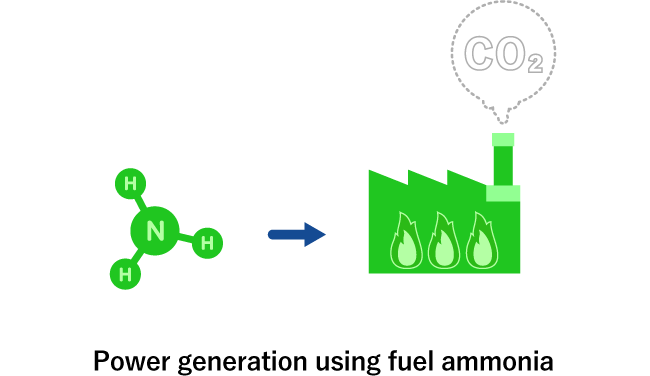
-

Thermal power generation is vital to
ensuring a stable supply of electricity,
but it mainly uses fossil fuels, so it
needs to be decarbonized.The main fuels used in thermal power generation are fossil fuels: oil, coal and natural gas. Coal in particular is a cheap and plentiful resource, but its high CO2 emissions has a huge environmental impact.
Renewable energy sources like solar and wind power generation are being introduced, but the amount of power to be generated is unstable over time, plus there are difficulties in storing the electricity produced on a large scale. To ensure a stable electricity supply, thermal power generation is indispensable, as it allows the amount of power generated to be flexibly adjusted.
This is why attention has turned to replacing fossil fuels with clean energy sources like hydrogen and ammonia, which do not emit CO2 when burned. Ammonia is easier to transport and store than hydrogen, so it is expected to come into practical use sooner.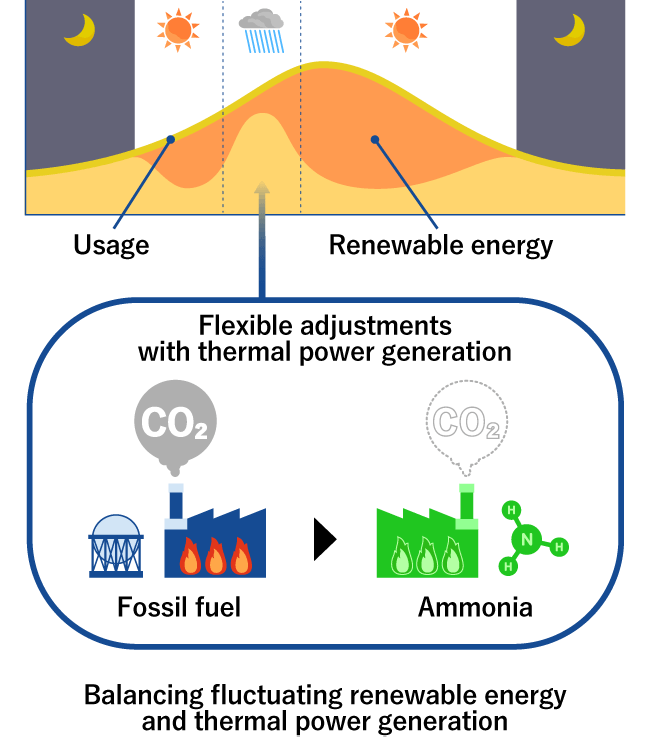
-

The challenges are developing
technology
for clean and stable
combustion of ammonia,
and putting an ammonia supply chain
into place.Technology for clean and
stable combustion of ammoniaIt is difficult to make ammonia burn in a stable way. If burned without putting measures in place, it emits nitrogen oxides (NOx) which cause air pollution. Advanced ammonia combustion technology is required to solve these issues.
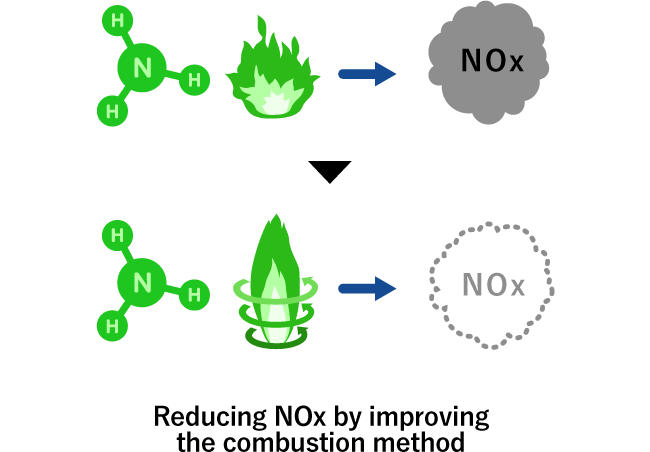
Putting an ammonia supply chain into place
In 2019, around 200 million tons of ammonia were produced globally, of which the trade volume was around 20 million tons; the rest is consumed locally, for use in fertilizers or chemical products. In future, if all Japan’s major power companies were to substitute 20% of fuel with ammonia at all thermal power plants, this would require approximately 20 million tons of ammonia annually*2. To meet growing demand, as well as facilities to produce large quantities of ammonia, we will need to establish systems to transport and store ammonia on a larger scale than ever before.
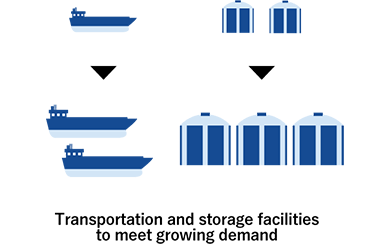
-

We are developing ammonia
combustion technology,
as well as technologies to produce,
transport and store green ammonia.Development of
ammonia combustion technologyIHI is developing advanced ammonia combustion technology to reduce emissions of nitrogen oxides (NOx). We have started testing this technology, substituting fossil fuels with ammonia in gas turbines, coal-fired power plants and marine engines, and these tests are going well.
In June 2022, natural gas was replaced completely with liquid ammonia to fuel the 2,000-kilowatt-class gas turbine at IHI Yokohama Office & Works. Emissions of CO2 and other greenhouse gases were reduced by over 99%, achieving CO2-free power generation*3.
In June 2024, we conducted the world’s first demonstration testing of fuel ammonia substitution at a large-scale commercial coal-fired power plant. 20% of coal was successfully substituted with ammonia at Unit 4 of JERA’s Hekinan Thermal Power Station in Aichi Prefecture (rated output: 1 million kW) *4.
It has been estimated that if all Japan’s major power companies were to substitute 20% of fuel with ammonia at all their coal-fired power plants, annual CO2 emissions would be reduced by 40 million tons; and if all these coal-fired power plants were replaced with 100% ammonia power plants, annual CO2 emissions would be reduced by 200 million tons*5.
IHI has also begun on replacing fossil fuels with ammonia to fuel ships. A tugboat equipped with an ammonia-fueled engine developed by IHI was completed and tested in August 2024. After the demonstration, the tugboat is now in commercial use*6.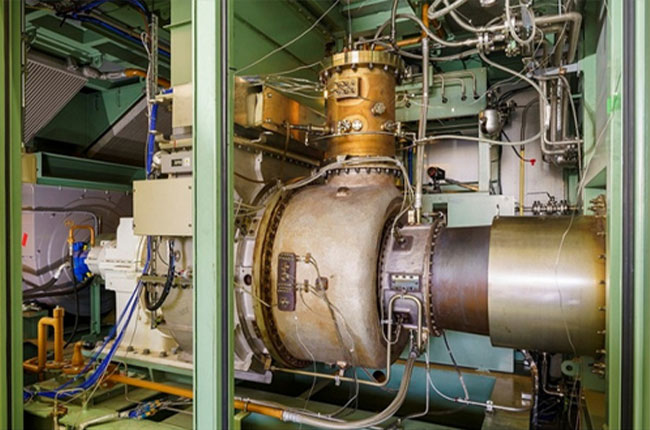
IHI’s ammonia-fired 2,000-kilowatt-class
gas turbine IM270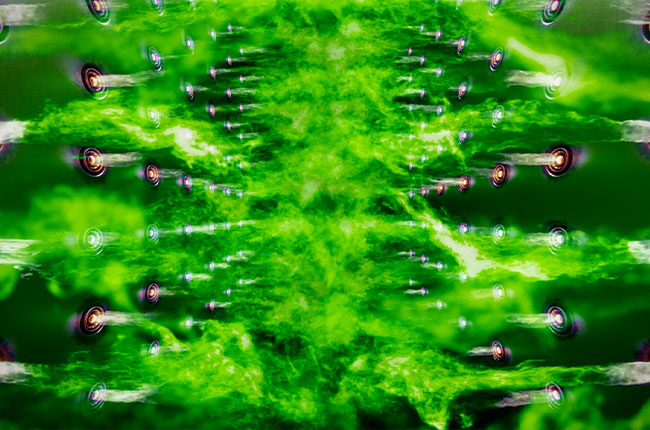
Image of ammonia combustion
Production of green ammonia
Hydrogen is a raw material of ammonia. When hydrogen is produced from fossil fuels, CO2 is emitted during the production process. Therefore, "green ammonia,” which uses hydrogen produced by renewable energy such as solar power, is attracting a lot of attention.
IHI is working with countries around the world to produce green ammonia.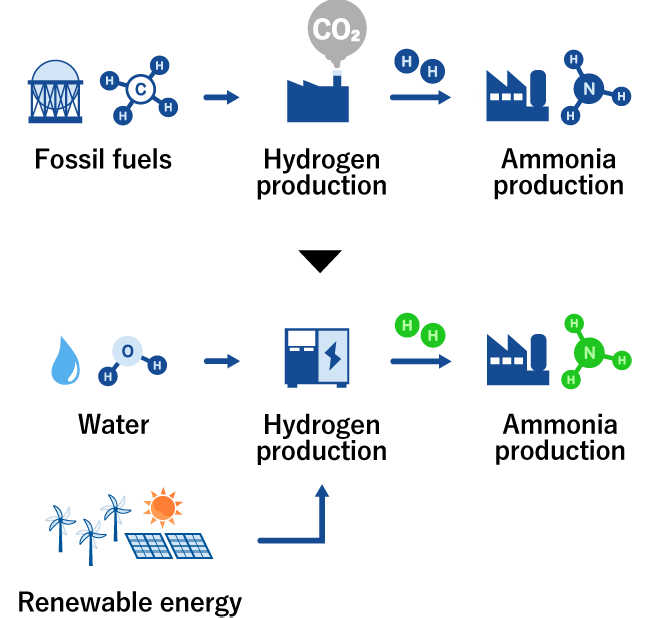
Development of transportation and
storage technologyWe are working hard to develop a large-scale ammonia receiving terminal that will be capable of receiving large quantities of imported ammonia, drawing on expertise gained from IHI’s extensive involvement in the construction of liquid natural gas (LNG) receiving terminals and storage tanks.
As for transportation, we are taking part in a project to develop an ammonia transportation ship equipped with a domestically produced ammonia-fueled engine, aiming to achieve decarbonization and mass transportation at the same time.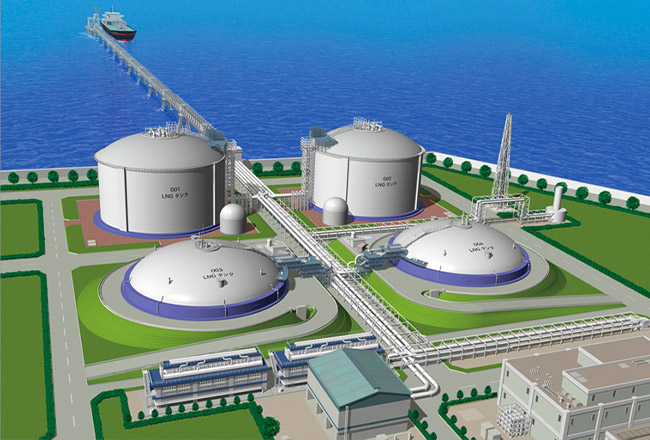
Image diagram of storage tanks
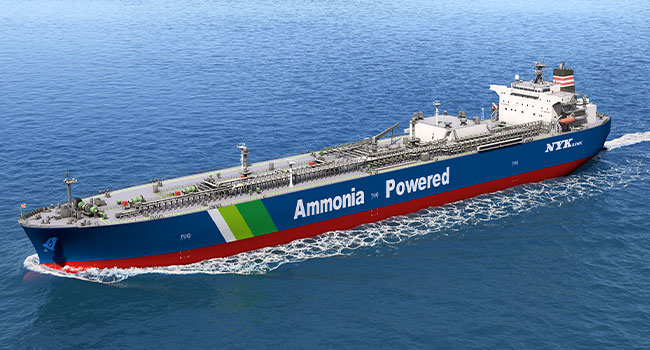
Ammonia-fueled ship to transport ammonia
- *3 This contents is based on results obtained from a project, JPNP21020, commissioned by the New Energy and Industrial Technology Development Organization (NEDO)
- *4 This contents is based on results obtained from a project, JPNP16002, subsidized by the New Energy and Industrial Technology Development Organization (NEDO)
- *5 Source : “Ammonia can be used as fuel! Part 1: Ammonia is commonly used in our daily life, but its potential is not widely known,” Agency for Natural Resources and Energy
- *6 This contents is based on results obtained from a project, JPNP21031, subsidized by the New Energy and Industrial Technology Development Organization (NEDO)
-

-
IHI Technology
Challenge aimed at decarbonization
through ammonia utilization technology -
IHI Engineering Review
Ammonia Energy Value Chain for Carbon Neutrality
from Production to Utilization -
IHI Engineering Review
Successful Demonstration Test of
Ammonia Firing Conducted at
Commercial Power Station
Results of demonstration test for ammonia
20%
firing at Hekinan Thermal Power
Station Unit 4 -
IHI Engineering Review
Realizing Large-Volume Ammonia Tanks
and Establishing New Test Method
Technology for realizing large-volume
ammonia tanks, considered difficult to
construct
-



